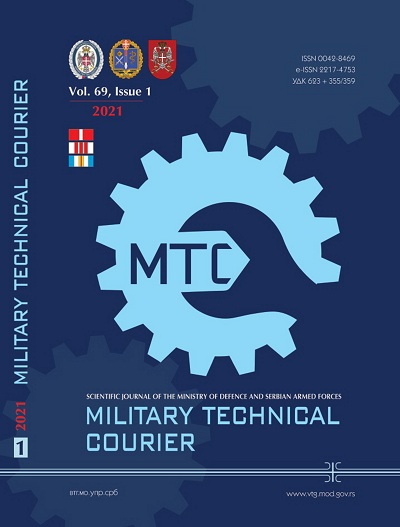Remediation of the areas contaminated by depleted uranium ammunition
Abstract
Introduction/goal: The consequences of the NATO aggression on the Republic of Serbia (then part of FR Yugoslavia) in 1999 are still being considered, especially from the aspect of the use of illicit means such as cluster and graphite bombs, depleted uranium ammunition (DUA), etc. There is no doubt that the use of depleted uranium, as a type of weapon of mass destruction (radiological weapon) is mostly in the focus of public interest. The amount of DUA used and the consequences of its use have not yet been fully proven (even after 20 years), but it can be said with certainty that it has caused certain side effects. The units of the Yugoslav Army at that time were mostly the target of this type of ammunition and certainly suffered the greatest consequences. However, DUA also targeted infrastructure facilities, base stations, television transmitters, and agricultural land.
Methods: Special scientific methods (mainly analysis and synthesis methods) and empirical methods (content analysis method and observation method) were used in the paper.
Results: The consequences of the effect of DUA on people, material goods, and environmental degradation are considered as well as the directions of further work in this area.
Conclusion: The paper presents the results of the radiological reconnaissance and radiological decontamination of the contaminated DUA areas, which were carried out by ABH service units (then ABHO) with the help of other branches and services of the Serbian Army, as well as the institutions of the Republic of Serbia (INS „Vinča“, MMA, etc.).
References
Arevalo, R.Јr., McDonough, W.F. & Luong, M. 2009. The K/U ratio of the silicate Earth: Insights into mantle composition, structure and thermal evolution. Earth and Planetary Science Letters, 278(3-4), pp.361-369. Available at: https://doi.org/10.1016/j.epsl.2008.12.023.
Binder, H.H. 1999. Lexikon der chemischen Elemente. Stuttgart; Leipzig: Verlag (in German). ISBN: 978-3-7776-0736-8.
Brauer, G. 1975. Handbuch der präparativen anorganischen Chemie. Stuttgart: Enke (in German). ISBN: 3432878133, 9783432878133.
Čekerevac, M. 2018. Imenovana Komisija za ispitivanje posledica NATO bombardovanja. Politika, 25 May [online]. Available at: http://www.politika.rs/sr/clanak/404403/Imenovana-Komisija-za-ispitivanje-posledica-NATO-bombardovanja (in Serbian) [Accessed: 10 October 2020].
Đurić, G.D. & Popović, D.Lj. 2000. Uranium in the environment. Hemijska industrija, 54(2), pp.50-52 [online]. Available at. https://scindeks-clanci.ceon.rs/data/pdf/0367-598X/2000/0367-598X0002050D.pdf (in Serbian) [Accessed: 10 October 2020].
Holleman, A.F., Wiberg, E. & Wiberg, N. 2007. Lehrbuch der Anorganischen Chemie. Berlin: de Gruyter (in German). ISBN: 978-3-11-017770-1.
Inđić, D. 2012. The place of NBC service units in protection against chemical accidents. Vojno delo, 64(1), pp.288-307 (in Serbian).
Inđić, D.R., Terzić, M.R., Žigić, S.V. & Rutić, S.Z. 2015. Engagement of the Serbian Army in helping civilians in the event of nuclear and chemical accidents. Vojnotehnički glasnik/Military Technical Courier, 63(3), pp.215-239 (in Serbian). Available at: https://doi.org/10.5937/vojtehg63-6923.
Inđić, D. 2018. Taktika jedinica ABH službe – udžbenik. Belgrade: University of defence in Belgrade – Military academy (in Serbian).
Inđić, D.R. & Filipović, V.R. 2018. Model snaga ABH službe za otklanjanje posledica primene radiološkog oružja u terorističke svrhe. Vojno delo, 70(4), pp.259-281 (in Serbian). Available at: https://doi.org/10.5937/vojdelo1804259I.
Meija, J., Coplen, T.B., Berglund, M., Brand, W.A., De Bièvre, P., Gröning, M., Holden, N.E., Irrgeher, J., Loss, R.D., Walczyk, T. & Prohaska, T. 2016. Atomic weights of the elements 2013 (IUPAC Technical Report). Pure and Applied Chemistry, 88(3), pp.265-291. Available at: https://doi.org/10.1515/pac-2015-0305.
Rajković, М.B. 2001. Depleted uranium I: Natural uranium, radioactivity and legal regulation. Hemijska industrija, 55(4), pp.167-182 [online]. Available at. https://scindeks-clanci.ceon.rs/data/pdf/0367-598X/2001/0367-598X0104167R.pdf (in Serbian) [Accessed: 10 October 2020].
-Serbian Armed Forces - General Staff. 2000. Uputstvo za protivnuklearno obezbeđenje Vojske Jugoslavije u uslovima upotrebe municije od osiromašenog uranijuma (privremeno). Belgrade: Serbian Armed Forces - General Staff. Directorate for NCBD (in Serbian).
-Serbian Armed Forces - General Staff. 2014. Uputstvo za RHB izviđanje i dozimetrijsku kontrolu. Belgrade: Serbian Armed Forces - General Staff (in Serbian).
Proposed Creative Commons Copyright Notices
Proposed Policy for Military Technical Courier (Journals That Offer Open Access)
Authors who publish with this journal agree to the following terms:
Authors retain copyright and grant the journal right of first publication with the work simultaneously licensed under a Creative Commons Attribution License that allows others to share the work with an acknowledgement of the work's authorship and initial publication in this journal.
- Authors are able to enter into separate, additional contractual arrangements for the non-exclusive distribution of the journal's published version of the work (e.g., post it to an institutional repository or publish it in a book), with an acknowledgement of its initial publication in this journal.
- Authors are permitted and encouraged to post their work online (e.g., in institutional repositories or on their website) prior to and during the submission process, as it can lead to productive exchanges, as well as earlier and greater citation of published work (See The Effect of Open Access).

